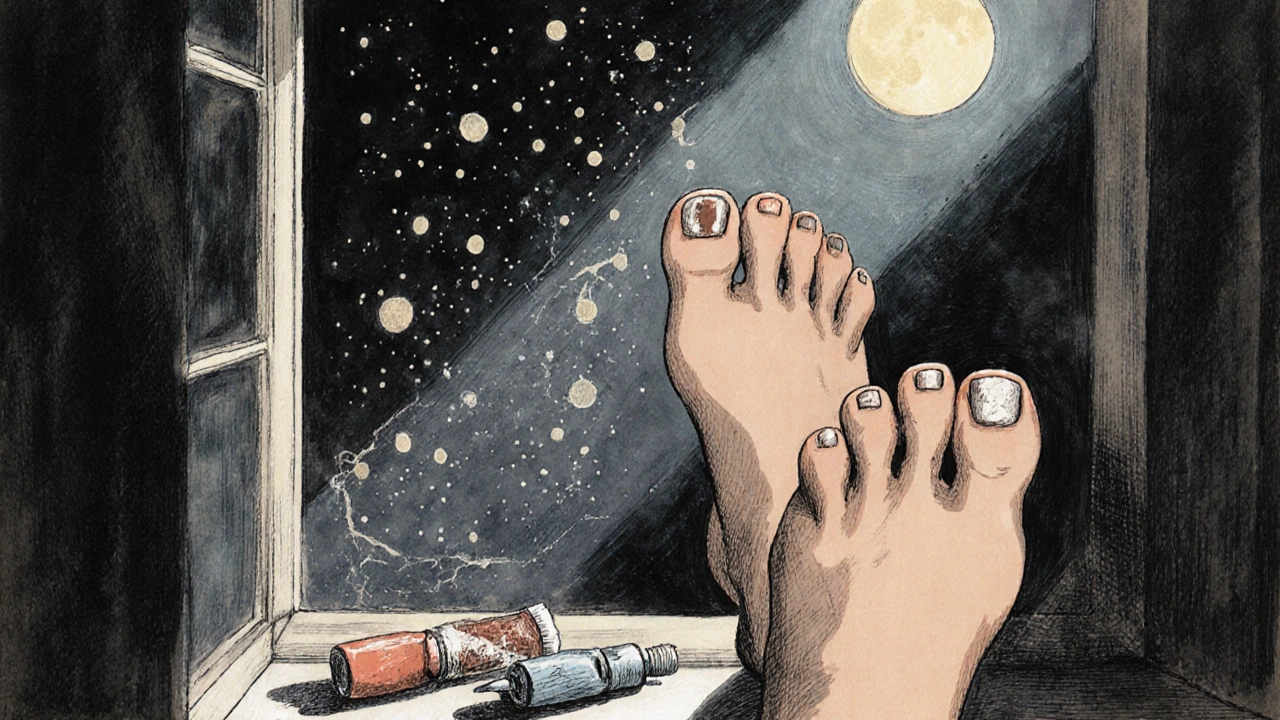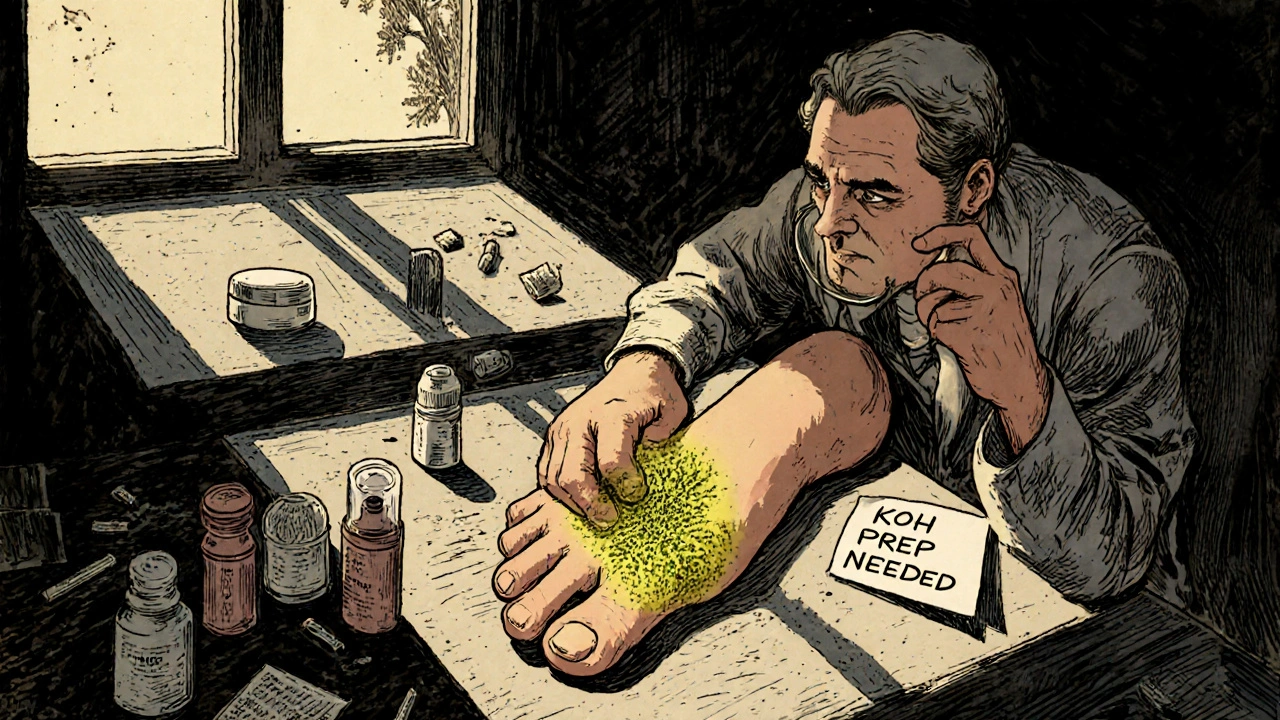18 Nov 2025
- 9 Comments
If you’ve got a stubborn itchy patch on your skin, thick yellow nails, or a rash that won’t quit even after weeks of over-the-counter creams, you might be dealing with a fungal infection-and it could need more than just a cream from the pharmacy. Terbinafine is one of the most effective oral treatments for certain types of fungal infections, but it’s not something you just start taking on your own. Knowing when to suspect a fungal cause-and when terbinafine might be the right move-can save you months of frustration and unnecessary treatments.
What Does a Fungal Infection Actually Look Like?
Fungal infections don’t always scream "fungus." They’re sneaky. They can hide under nails, between toes, or in skin folds where moisture lingers. The most common types that respond to terbinafine are onychomycosis (nail fungus) and tinea corporis (ringworm of the body), but they can also show up as tinea pedis (athlete’s foot) or tinea cruris (jock itch).
For nail fungus, look for nails that are:
- Thickened or distorted in shape
- Yellow, brown, or white in color
- Brittle, crumbly, or separating from the nail bed
- Sometimes with a foul odor
On the skin, fungal rashes often appear as:
- Red, circular patches with raised, scaly edges
- A clearer center, giving a "ring" appearance (classic ringworm)
- Itchy, sometimes burning or stinging
- Spreading slowly over weeks, not days
Here’s the catch: eczema, psoriasis, and even bacterial infections can mimic these signs. That’s why guessing isn’t enough.
Why Terbinafine? How It Works
Terbinafine isn’t just another antifungal. It’s a specific type called an allylamine. Unlike older drugs like fluconazole or itraconazole, terbinafine targets the fungus at its core-by blocking an enzyme called squalene epoxidase. This stops the fungus from making ergosterol, a key building block of its cell membrane. Without it, the fungus literally falls apart.
That’s why terbinafine is often the first choice for nail fungus. Studies show it cures about 70-80% of toenail fungal infections after 12 weeks of treatment, compared to 50-60% with older drugs. It also clears skin infections faster, usually within 2-4 weeks.
But here’s what most people don’t realize: terbinafine only works if the fungus is actually there. Taking it for a rash that’s really eczema won’t help-and could expose you to side effects for no reason.
When You Should Suspect a Fungal Infection Worth Treating with Terbinafine
Not every itchy patch needs oral meds. But there are clear red flags that suggest you’re dealing with a deep or stubborn fungal infection that may need terbinafine:
- You’ve tried topical antifungals (like clotrimazole or miconazole) for 4-6 weeks with no improvement.
- The infection is on your nails, especially toenails. Topical creams rarely penetrate thick nails well enough to cure the infection.
- The rash is spreading despite good hygiene-no improvement with steroid creams (which can actually make fungal infections worse).
- You have diabetes, a weakened immune system, or circulatory problems. Fungal infections in these cases can become serious if left untreated.
- You’ve had recurring infections in the same spot. Fungi love to come back if not fully eradicated.
For example, a 52-year-old woman in Bristol came in with thick, discolored toenails she’d been treating for two years with nail polish and creams. She didn’t have pain, but the nails were ugly and kept growing back worse. A simple nail clipping sent to the lab confirmed Trichophyton rubrum-the most common nail fungus. She started terbinafine 250 mg daily for 12 weeks. By month 6, new nail growth was clear. She didn’t need surgery.
What Tests Confirm a Fungal Infection?
Doctors don’t just guess. There are two reliable ways to confirm a fungal infection before prescribing terbinafine:
- KOH prep: A tiny scraping of skin or nail is mixed with potassium hydroxide and looked at under a microscope. Fungal threads (hyphae) show up clearly. Fast, cheap, and often done in the clinic.
- Fungal culture: A sample is sent to a lab to grow the fungus. Takes 2-6 weeks, but it tells you exactly which species you’re dealing with. This matters because some fungi don’t respond well to terbinafine.
PCR tests are becoming more common too-they detect fungal DNA quickly. But they’re not always covered by insurance and aren’t needed in straightforward cases.
Don’t let a doctor skip testing just because "it looks like fungus." Misdiagnosis is common. One UK study found nearly 30% of suspected nail fungus cases were actually psoriasis or lichen planus. You don’t want to take terbinafine for six months only to find out it was never a fungus.

Who Shouldn’t Take Terbinafine?
Terbinafine is safe for most people-but not everyone. It’s processed by the liver, so you need to be careful if:
- You have liver disease or abnormal liver tests
- You’re taking other medications that affect the liver (like certain antidepressants, statins, or oral contraceptives)
- You have autoimmune conditions like lupus
- You’re pregnant or breastfeeding
Side effects are usually mild-headache, upset stomach, taste changes-but about 1 in 100 people report more serious issues like liver inflammation or severe skin reactions. That’s why your doctor will likely check your liver enzymes before and after treatment.
Also, don’t drink alcohol while taking terbinafine. It can increase liver stress and make side effects worse.
What Happens After Treatment?
Terbinafine doesn’t work instantly. For skin infections, you’ll start to feel better in a week or two. But for nails, you’re waiting for new, healthy nail to grow out. That takes time-up to 6 months for fingernails, 12 months for toenails.
Even if the nail looks fine halfway through, finish the full course. Stopping early is the #1 reason fungal infections come back.
After treatment, keep your feet dry. Wear breathable shoes. Don’t walk barefoot in gyms or pools. Fungi thrive in warm, damp places. Use antifungal powder once a week as a preventive measure.
What Are the Alternatives?
Terbinafine isn’t the only option, but it’s often the best. Other treatments include:
| Treatment | Best For | Duration | Success Rate | Side Effects |
|---|---|---|---|---|
| Terbinafine (oral) | Nail fungus, stubborn skin infections | 6-12 weeks | 70-80% | Mild GI issues, taste changes, rare liver impact |
| Itraconazole (oral) | Yeast-related or mixed infections | 3-6 months (pulsed) | 50-70% | More drug interactions, heart risks |
| Topical antifungals (e.g., ciclopirox) | Mild skin or early nail changes | 3-12 months | 10-30% | Local irritation |
| Laser treatment | Patients avoiding oral meds | Multiple sessions | 30-50% (uncertain long-term) | Costly, not covered by NHS |
Topical treatments alone rarely cure nail fungus. Laser therapy sounds high-tech, but it’s expensive and not proven to be better than terbinafine. Itraconazole works well for some types of yeast infections, but it interacts with more medications and requires liver monitoring too.

When to See a Doctor
You don’t need to wait until your nails look terrible. See a GP or dermatologist if:
- A rash hasn’t improved after 2 weeks of OTC antifungal cream
- Your nails are changing color or thickening
- You have diabetes or a weakened immune system
- You’re in pain or the infection is spreading quickly
Don’t assume it’s "just a fungus" because it looks like one. Get it checked. A simple scrape can save you months of ineffective treatments.
Preventing Fungal Infections After Treatment
Curing the infection is only half the battle. Fungi are everywhere-on shower floors, in socks, under toenails. To keep it from coming back:
- Always dry your feet thoroughly, especially between toes
- Wear moisture-wicking socks (cotton or merino wool, not synthetic)
- Rotate your shoes-don’t wear the same pair two days in a row
- Use antifungal spray in your shoes once a week
- Never share towels, nail clippers, or shoes
- Wear flip-flops in public showers and pools
Many people forget that fungal infections can live in bedding and towels. Wash them in hot water after treatment. And if you’ve had nail fungus, consider replacing old nail tools or disinfecting them with rubbing alcohol.
Can terbinafine cure nail fungus completely?
Yes, terbinafine is one of the most effective treatments for nail fungus, with cure rates between 70% and 80% when taken correctly for the full course. However, it takes time-new healthy nail grows slowly, so you may not see full results for up to a year after finishing treatment. Success depends on finishing the entire course and preventing reinfection.
How long does terbinafine take to work?
For skin infections, you’ll usually notice improvement within 1-2 weeks. For nail infections, it takes longer because the drug works as new nail grows out. You won’t see visible changes for 2-3 months, and full clearance can take 6-12 months. Don’t stop early just because it looks better.
Is terbinafine safe for long-term use?
Terbinafine is typically prescribed for 6 to 12 weeks, which is considered safe for most people. Long-term use beyond this is rare and only done under specialist supervision due to potential liver effects. Liver function tests are usually done before and after treatment to monitor safety.
Can I use terbinafine if I have liver problems?
No. Terbinafine is processed by the liver, so it’s not recommended if you have active liver disease, cirrhosis, or abnormal liver enzyme levels. Your doctor will check your liver function before prescribing it. If you’ve had liver issues in the past, discuss alternatives like topical treatments or laser therapy.
Are there natural remedies that work as well as terbinafine?
Tea tree oil, vinegar soaks, and coconut oil are popular, but studies show they’re not as effective as terbinafine for deep or persistent infections. They may help with mild symptoms or as a preventive, but they won’t reliably cure nail fungus or stubborn skin infections. Relying on them alone can delay proper treatment and let the infection spread.
Final Thoughts
Fungal infections are common, but they’re not always easy to spot-and they’re even harder to treat without the right approach. Terbinafine is powerful, but it’s not a magic pill. It works best when you’re sure it’s needed. Get a proper diagnosis. Follow the full course. Take care to prevent reinfection. And don’t let a stubborn nail or rash go ignored just because it doesn’t hurt. The right treatment can get you back to normal-without the embarrassment, the itch, or the waiting.


Jenny Lee
November 19, 2025This nailed it. I had fungus for years and thought it was eczema. Terbinafine? Game changer. Now my nails look normal again. 🙌
Jeff Hakojarvi
November 19, 2025Just wanna say thanks for this breakdown. I’m a nurse and see so many people waste months on steroid creams thinking it’s psoriasis. The KOH prep is so simple but so underused. I always push for it now. Also, side note: don’t forget to wash your sheets after treatment. Fungi live in cotton like it’s a spa resort. 🤦♂️
Timothy Uchechukwu
November 21, 2025Why are we giving western medicine all the credit? In Nigeria we use neem leaves and garlic paste for generations. No blood tests no prescriptions just pure African wisdom. You people overcomplicate everything. Terbinafine is just a fancy name for what our grandmas did with fire and leaf
Ancel Fortuin
November 22, 2025Of course terbinafine works. Big Pharma paid the FDA to approve it. Did you know the real cure is magnetic therapy and drinking distilled water during a full moon? They don’t want you to know that because it’s free. Also your liver? It’s fine. The real danger is 5G towers syncing with your sweat glands. I’ve seen the documents.
Hannah Blower
November 23, 2025How tragic that we’ve reduced the sacred act of healing to a chemical algorithm. Terbinafine is just another tool of biomedical hegemony. You treat the symptom, not the soul’s dissonance. That nail fungus? It’s your fear of growth. Your refusal to shed old layers. The fungus is a metaphor. You want a cure? Stop blaming dermatophytes and start examining your relationship with moisture. Literal and emotional. 🌱
Gregory Gonzalez
November 25, 202570-80% success rate? Cute. That’s just statistically significant enough for a drug rep to buy lunch. Realistically? Half the people who take it don’t finish because they get that metallic taste and suddenly remember they hate everything. And don’t get me started on the ‘finish the course’ nonsense. If your body’s screaming for mercy, why are you still swallowing pills like a good little cog?
Ronald Stenger
November 26, 2025Let’s be real - this whole post is just a corporate ad disguised as medical advice. Terbinafine? Made in Switzerland. Imported. Overpriced. Meanwhile in rural Africa, India, and even parts of Appalachia, people cure this with vinegar and sunlight. But no - we gotta pump our kids full of pills so the insurance companies can profit. Wake up.
Samkelo Bodwana
November 26, 2025I’ve been thinking about this a lot lately. There’s something beautiful in how nature works - fungi are just trying to survive, same as us. Maybe instead of wiping them out with chemicals, we should ask why they’re attracted to us in the first place. Is it our shoes? Our sweat? Our stress? Our diets? Terbinafine fixes the symptom, sure, but what if the real issue is that we live in damp socks metaphorically and literally? I’ve switched to bamboo socks, air out my feet every night, and stopped using synthetic deodorants. My fungus hasn’t returned in 3 years. No pills. Just awareness. Maybe healing isn’t about domination - it’s about harmony.
Emily Entwistle
November 27, 2025OMG YES this is so helpful!! I’ve been dealing with this for years 😭 I tried everything - tea tree oil (smelled like a forest fire), vinegar soaks (my feet smelled worse), even that weird laser thing at the spa (cost $500 and did NOTHING). Terbinafine? 12 weeks. Done. Nails are growing back clean. I’m crying happy tears 💕 Also, wash your towels people!! 🧼🧺